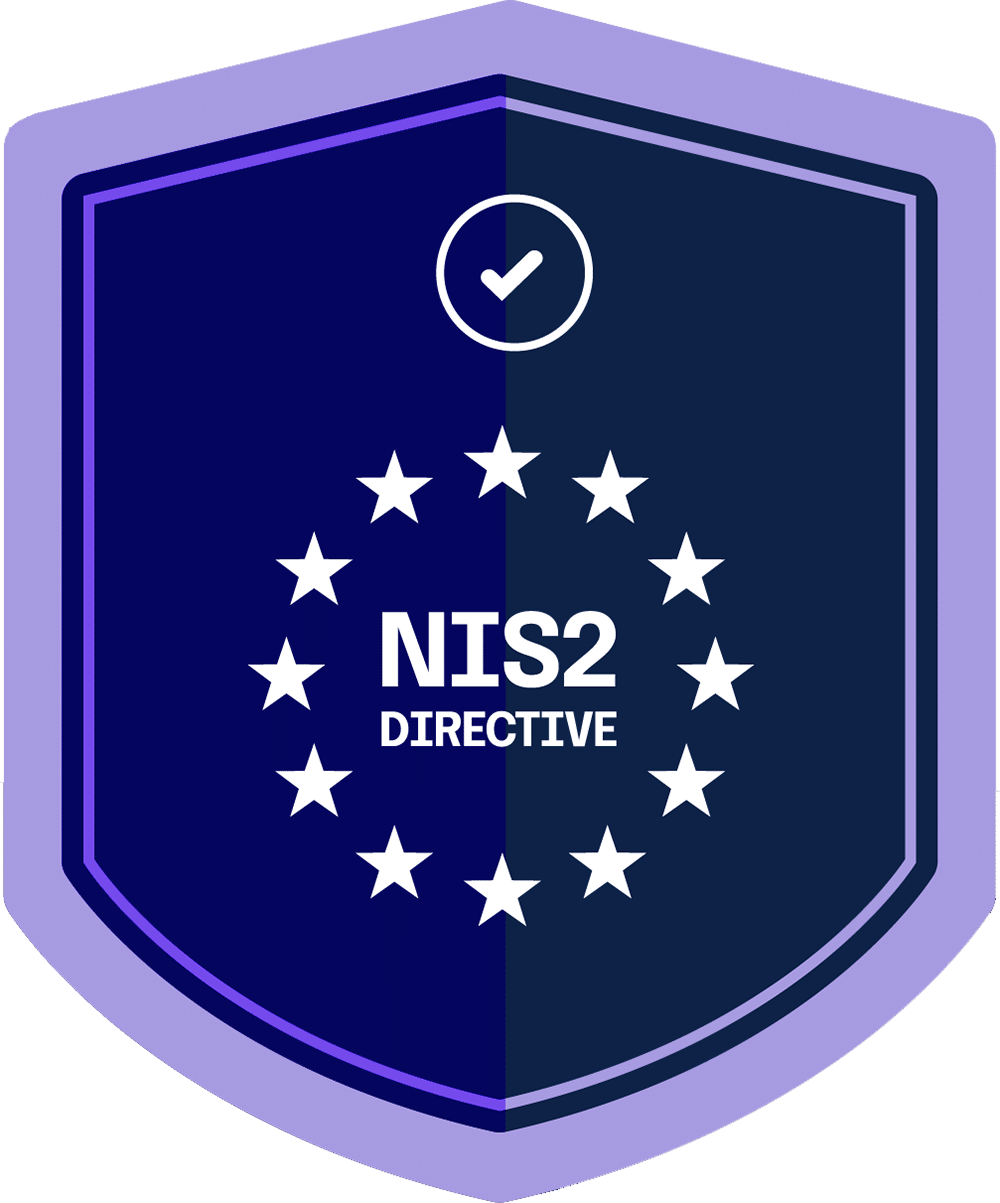
The Ultimate Guide to
NIS2 Compliance: A Detailed and Practical Guide to the NIS2 Directive
The Network and Information Security Directive (NIS2) is the EU’s latest cybersecurity legislation aimed at improving the resilience of critical infrastructure and essential services across member states. If your organization is classified as an essential or important entity under NIS2 and operates within EU member states, understanding NIS2 is essential.
What is NIS2?
NIS2 (Directive (EU) 2022/2555) is the updated version of the EU’s original Network and Information Security Directive (NIS), which was introduced in 2016. Officially adopted on January 16, 2023, with a transposition deadline of October 17, 2024, for member states to implement the directive into national law, NIS2 establishes a higher common level of cybersecurity across the EU. Its primary goal is to ensure that essential and important entities take appropriate security measures and report significant incidents to national authorities.
NIS2 enhances the EU’s cybersecurity baseline by:
- Expanding the scope to more sectors and entities
- Imposing stricter risk management and incident reporting requirements
- Introducing stronger enforcement, including substantial fines and leadership accountability
Who does NIS2 apply to?
NIS2 applies to a wide range of organizations operating within the EU, including non-EU companies offering services in the EU. The directive distinguishes between essential entities (higher regulatory scrutiny) and important entities (subject to ex post supervision where audits and inspections occur only when there is reasonable suspicion of violations, but still required to comply with the directive’s requirements).
Sectors covered under NIS2:
Essential entities (Annex I)
These entities are held to the highest level of scrutiny under NIS2.
Important entities (Annex II)
These sectors are also considered significant, but with slightly lower risk exposure. They must meet all NIS2 obligations, but are subject to ex post supervision that is triggered only when there is evidence of potential violations.
Size cap rule
In general, NIS2 applies to medium and large organizations (50+ employees or €10M+ turnover). However, some smaller organizations may also fall under the directive if they are deemed critical to society or the economy.
What are the key differences between NIS1 and NIS2?
The NIS2 Directive represents a significant evolution from the original NIS Directive (NIS1), addressing its shortcomings and adapting to today’s more complex threat landscape. While NIS1 laid the foundation for EU-wide cybersecurity regulation, NIS2 broadens the scope, deepens enforcement mechanisms, and harmonizes implementation across member states.
Here’s a breakdown of the most important and specific differences between NIS1 (2016) and NIS2 (2023):
Scope and sector coverage
NIS2 dramatically expands who is covered and removes ambiguity by standardizing thresholds and sector definitions.
NIS1
NIS1 is applied only to a narrow set of Operators of Essential Services (OES) (e.g., energy, transport, healthcare) and Digital Service Providers (DSPs) (e.g., cloud services, search engines). Each member state defined who qualified as an “essential” operator, leading to inconsistencies across the EU.
NIS2
NIS 2 applies to a much broader range of entities across critical and important sectors defined in Annexes I and II. It introduces a two-tier classification:
NIS2 also uses size-cap rules (250+ employees or €50M+ revenue for essential entities, with medium and large-sized companies in selected sectors included in scope) to determine applicability, improving consistency across the EU. The framework includes public administration bodies, space infrastructure, and wider digital services that were not covered under NIS1.
Security risk management requirements
NIS2 provides concrete expectations for cyber hygiene, making compliance more measurable and enforceable.
NIS1
Introduces detailed cybersecurity risk management obligations in Article 21, including:
NIS2
NIS2 provides concrete expectations for cyber hygiene, making compliance more measurable and enforceable.
Entities must establish policies and procedures to assess the effectiveness of cybersecurity risk-management measures.
Incident reporting obligations
NIS2 standardizes incident reporting and introduces real-time operational accountability.
NIS1
NIS2
Governance and accountability
Cybersecurity is no longer just IT’s responsibility, and executives are now personally accountable.
NIS1
NIS2
Enforcement penalties
NIS2 introduces true enforcement penalties. Failure to comply now carries significant business and legal consequences.
NIS1
NIS2
Cross-border coordination and harmonization
NIS2 aims to unify cybersecurity posture across all EU member states, enabling faster and more coherent responses to threats.
NIS1
NIS2
Supply chain and third-party risk
NIS2 treats third-party risk as a core cybersecurity issue, not an optional add-on.
NIS1
NIS2
NIS2 cybersecurity requirements
You can read the official full text of the NIS2 Directive here:
NIS2 Directive (Directive (EU) 2022/2555) – EUR-Lex Official Source
The directive is available in all official EU languages and includes all articles and annexes that specify requirements, definitions, and enforcement mechanisms.
Under Article 21 of the NIS2 directive, all covered entities must implement technical, operational, and organizational cybersecurity risk management measures, including:
- Risk analysis and policies for information system security
- Incident handling and response procedures
- Business continuity and crisis management plans
- Supply chain security, including third-party risk assessments
- Security in network and information systems acquisition, development, and maintenance
- Vulnerability handling and disclosure procedures
- Policies and procedures for evaluating the effectiveness of cybersecurity measures
- Use of multi-factor authentication or continuous authentication solutions and policies and procedures regarding the use of cryptography and, where appropriate, encryption
- Training and awareness programs for employees
- Governance structures with clear roles and responsibilities
Entities must also maintain incident reporting capabilities, with specific timeframes:
What is the structure of the NIS2 framework?
The NIS2 Directive is structured into six chapters and two annexes. Each section outlines specific obligations for entities, responsibilities for EU member states, and mechanisms for cross-border coordination. Here’s a breakdown of what each section includes:
Chapter I: General Provisions (Articles 1–6)
This chapter is critical for understanding how the law defines responsibilities and actors, including whether your organization falls under the directive’s jurisdiction.
What it covers:
Chapter II: Cybersecurity Risk Management and Reporting Obligations (Articles 7–23)
Chapter II is the most operationally significant section for companies, as it defines what organizations must do to comply with NIS2.
What it covers:
Chapter III: Jurisdiction and Supervision of Essential and Important Entities (Articles 24–36)
Chapter III outlines how essential and important entities are assigned to national competent authorities (NCAs), introduces risk-based approaches to supervision and outlines cooperation among national authorities.
What it covers:
Chapter IV: Coordinated Vulnerability Disclosure and Database (Articles 27–29)
Chapter IV supports transparency and EU-wide situational awareness on emerging threats.
What it covers:
Chapter V: Cyber Crisis Management Framework (Articles 30–36)
Chapter V ensures structured and rapid responses to widespread cyberattacks that threaten public order or economic stability.
What it covers:
Chapter VI: Final Provisions (Articles 37–45)
This chapter provides the legal and procedural context for the directive’s implementation and future updates.
What it covers:
NIS2 Directive frequently asked questions
How Hyperproof helps with NIS2 compliance
With real-time risk monitoring, incident response tracking, and automated workflows, Hyperproof simplifies meeting NIS2 obligations, reducing the burden of compliance and enhancing overall cybersecurity resilience.

Jumpstart your NIS2 compliance journey with a pre-built framework template, including optional ISO 27001 and 27002 illustrative controls.
Collect, manage, and monitor your risks and ensure risk mitigation work is prioritized and completed based on customizable inherent impact and tolerance.
Crosswalk controls between programs to speed up NIS2 implementation. Avoid duplicative work and adhere to other frameworks, like the EU CRA, NIST CSF, GDPR, DORA, ISO 27001, and more.
Get clear insights into your team’s progress on assessment requests with our dashboards and reports, designed for easy sharing with key stakeholders.
Automatically assign tasks to meet NIS2 directive requirements and streamline workflows to boost efficiency, ensuring you never face delays.
Leverage Hyperproof’s powerful integrations, including AWS, Azure, Github, Jira, and more to automate evidence collection and reuse that evidence across multiple controls.
Ready to see
Hyperproof in action?









